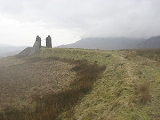
Rhiwbach Tramway
Encyclopedia
The Rhiwbach Tramway was a British industrial
narrow gauge railway connecting the remote slate quarries
east of the Blaenau Ffestiniog
with the Ffestiniog Railway
.
The quarries connected to the tramway had no practical road access as they lay at an altitude of around 1560 ft (475 m) above sea level in a remote moorland. The tramway rose by three inclines
through Maenoffren quarry to reach the plateau, where it ran on an approximately level course east towards Cwt y Bugail Quarry
. From there the line turned south to the head of the incline down to the Rhiwbach quarry which lay below the plateau in the Machno valley.
The tramway was originally designed to be worked by horses and gravity. Sometime in the 1920s petrol locomotives were introduced. In 1953 the Rhiwbach Quarry closed, leaving the Cwt y Bugail Quarry as the only user of the main section of the tramway. The track from Rhiwbach to Cwt y Bugail was lifted in 1956 and the section from Cwt y Bugail to Maenofferen was closed in 1961 and lifted in 1964.. A short section remained in use between the mills at Maen Offeren to the foot of Rhiwbach No 2 Incline. This section was finally closed c1976 after a new quarry road was built connecting the upper levels of Llechwedd with the mills at Maen Offeren. This resulted in the last remaining gravity incline in the North Wales slate industry being redundant. Most of the last track was lifted in 1964, although short sections remain intact as late as 2007.
British narrow gauge slate railways
The slate industry of North Wales was the largest user of narrow gauge railways in the whole of the United Kingdom. Many of the quarries had internal tramways and feeder lines connecting them to transhipment points on local railways, rivers, roads or coastal ports....
narrow gauge railway connecting the remote slate quarries
Slate industry
The slate industry is the industry related to the extraction and processing of slate. Slate is either quarried from a slate quarry or reached by tunneling in a slate mine. Common uses for slate include as a roofing material, a flooring material, gravestones and memorial tablets, and for electrical...
east of the Blaenau Ffestiniog
Blaenau Ffestiniog
Blaenau Ffestiniog is a town in Gwynedd, north-west Wales. It has a population of 5,000, including Llan Ffestiniog, which makes it the third largest town in Gwynedd, behind Caernarfon & Porthmadog. Although the population reached 12,000 at the peak of the slate industry, the population fell due to...
with the Ffestiniog Railway
Ffestiniog Railway
The Ffestiniog Railway is a narrow gauge heritage railway, located in Gwynedd, Wales. It is a major tourist attraction located mainly within the Snowdonia National Park....
.
History
The tramway was built by the Festiniog Slate Quarry Co. Ltd. in 1863 to carry slate from the Rhiwbach quarry to the Ffestiniog Railway's Duffws Station.The quarries connected to the tramway had no practical road access as they lay at an altitude of around 1560 ft (475 m) above sea level in a remote moorland. The tramway rose by three inclines
Cable railway
A cable railway is a steeply graded railway that uses a cable or rope to haul trains.-Introduction:...
through Maenoffren quarry to reach the plateau, where it ran on an approximately level course east towards Cwt y Bugail Quarry
Cwt y Bugail Quarry
The Cwt y Bugail Quarry was a slate quarry located east of Blaenau Ffestiniog in Wales. It was first worked as a trial pit around 1840. Continuous production began in 1863 and continued until closure in 1961...
. From there the line turned south to the head of the incline down to the Rhiwbach quarry which lay below the plateau in the Machno valley.
The tramway was originally designed to be worked by horses and gravity. Sometime in the 1920s petrol locomotives were introduced. In 1953 the Rhiwbach Quarry closed, leaving the Cwt y Bugail Quarry as the only user of the main section of the tramway. The track from Rhiwbach to Cwt y Bugail was lifted in 1956 and the section from Cwt y Bugail to Maenofferen was closed in 1961 and lifted in 1964.. A short section remained in use between the mills at Maen Offeren to the foot of Rhiwbach No 2 Incline. This section was finally closed c1976 after a new quarry road was built connecting the upper levels of Llechwedd with the mills at Maen Offeren. This resulted in the last remaining gravity incline in the North Wales slate industry being redundant. Most of the last track was lifted in 1964, although short sections remain intact as late as 2007.
Locomotives
This table shows locomotives known to have worked the Rhiwbach Tramway.| Builder | Type | Works Number | Built | Notes |
|---|---|---|---|---|
| Ruston and Hornsby Ruston (engine builder) Ruston & Hornsby, later known as Ruston, was an industrial equipment manufacturer in Lincoln, England, the company's history going back to 1840. The company is best known as a manufacturer of narrow and standard gauge diesel locomotives and also of steam shovels. Other products included cars, steam... |
4wD | 223687 | 1944 | Purchased before 1949 by the Cwt y Bugail Quarry, used on the Rhiwbach Tramway from 1953 to 1961, scrapped at Cwt y Bugail 1974-1977 |
External links
- Rhiwbach Tramway - photos of a walk along the lower section of the tramway

